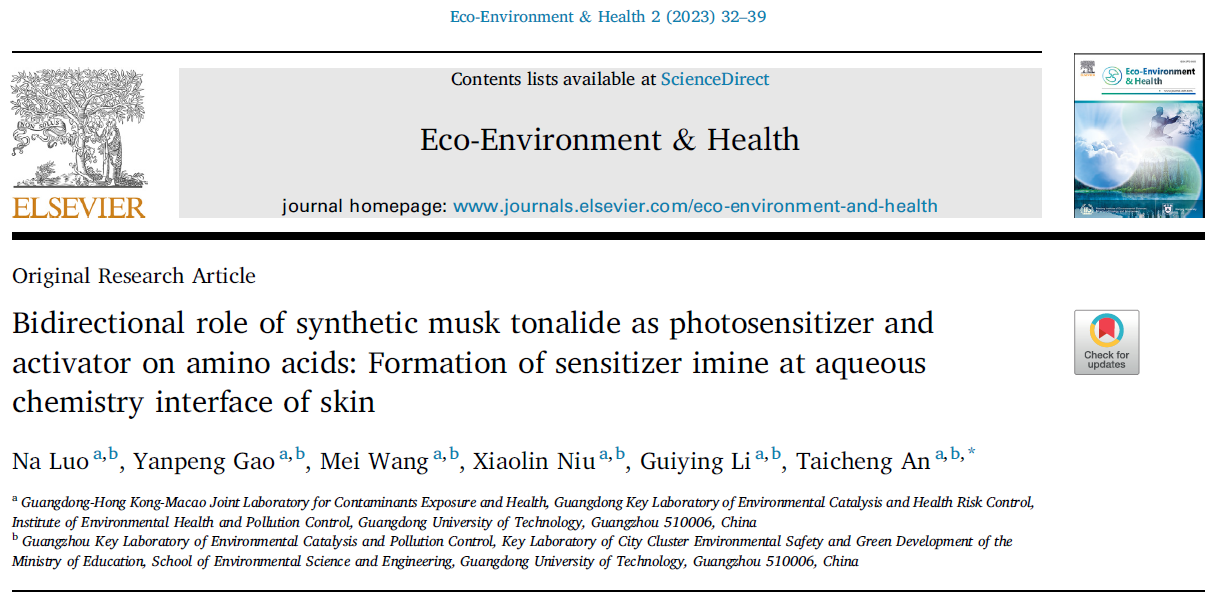近日,广东工业大学环境健康与污染控制研究院、环境科学与工程学院安太成教授团队在国际期刊Eco-Environment & Health (2 (2023) 32–39 ) 上发表题为"Bidirectional role of synthetic musk tonalide as photosensitizer and activator on amino acids: Formation of sensitizer imine at aqueous chemistry interface of skin"的研究论文。论文的第一作者为博士生罗娜,通讯作者为安太成教授。

论文网址:https://doi.org/10.1016/j.eehl.2023.03.002
个人护理产品(PCPs)在日常生活中不可避免地与皮肤接触,可能对人体健康产生不良影响。合成麝香作为典型的PCPs,已被广泛地用于各种日用化学品中。报道指出合成麝香可快速富集在皮肤表层,还可以通过光诱导氧化损伤氨基酸。换言之,残留在皮肤表面的合成麝香会作为光敏剂破坏人体组织结构中的关键生物分子。特别是在皮肤过度暴露于紫外线下时,这可能会导致皮肤致敏效应。然而,在紫外线照射下,皮肤表面残留的合成麝香发生光化学转化过程中的光敏潜能和致敏机制尚不清楚。因此,尽早识别典型PCPs的潜在皮肤致敏性,对降低其对人体皮肤的不良健康影响具有重要意义。
在本研究中,为了清楚地了解典型个人护理产品对人体皮肤的损伤,我们以典型的氨基酸(组氨酸、甘氨酸和甲硫氨酸)模拟人体组织的基本组成部分,研究了合成麝香Tonalide(AHTN)在氨基酸存在下的光化学转化过程与机制。结果表明:典型氨基酸(组氨酸、甘氨酸和甲硫氨酸)可显著性降低AHTN的光化学转化速率,增加AHNT在皮肤表面滞留的可能性,从而有可能增加人体皮肤健康的风险。进一步研究表明,AHTN对典型氨基酸(组氨酸、甘氨酸和甲硫氨酸)的氧化损伤具有双向作用,即AHTN在紫外光照下可以同时作为光敏剂和激活剂。作为一种光敏剂,AHTN光敏作用产生的1O2可以诱导氨基酸的氧化损伤。同时本工作将实验结果与量子化学计算结果相结合,发现AHTN也是一种激活剂,AHTN的羰基是激活氨基酸含N基团(包括共有的α-NH3和特异的侧链基团)的活性位点。提出激活机制为AHTN与氨基酸之间的电子转移,并且在AHTN的光化学转化过程中激活氨基酸形成了亚胺化合物这一关键降解产物。这一过程被认为是潜在的皮肤致敏有害结局途径(Adverse outcome pathway,AOP)的分子起始事件(Molecular initiating event,MIE)。本研究首次报道了AHTN光化学转化过程中皮肤光敏剂的形成,对人体皮肤健康存在潜在威胁,可以为未来AHTN的使用与标准制定提供一定的科学依据。
图文摘要:

英文摘要:
Personal care products (PCPs) inevitably come into contact with the skin in people’s daily life, potentially causing adverse effects on human health. Especially the adverse effects would be exacerbated under UV irradiation but it is rarely attempted. In this study, to clearly understand the damage of representative PCPs to human skin, the photochemical transformation behaviors of representative PCPs, fragrance tonalide (AHTN), were measured in the presence of amino acids as a basic building block of human tissue. The results showed that amino acids could decelerate the photochemical transformation rate of AHTN, increasing the likelihood of AHNT persisting on the skin surface and the health risk to the human being. Further, the interaction between amino acids and AHTN was investigated. AHTN could play bidirectional roles in damaging amino acids: the photosensitizer and reactive activator. As a photosensitizer, the 1O2 generated from the AHTN photosensitization was partly employed to oxidative damage amino acids. Furthermore, as an activator, combined experiments with quantum chemical computation, the carbonyl group of AHTN was found to be the active site to activate the N-containing group of amino acids. The activation mechanism was the electron transfer between AHTN and amino acids. Imines formed during photochemical transformation of AHTN with histidine/glycine were as the molecular initiating event as potential skin sensitization. This study reported for the first time that skin photosensitizer formation threatened human health during the photochemical transformation of AHTN.